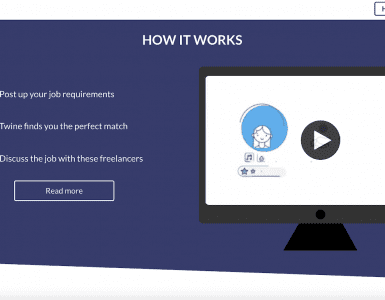If it’s your job to manage freelancers, giving feedback can often be the hardest part of your working relationship. Feedback is an integral part of your workflow. It enables you to iron out problems, improve and move forward. It’s great for solidifying your relationship with your freelancer, and a chance for you to give them a well-earned pat on the back.
But, it can be a difficult thing to get right, especially when you have negative news to deliver. There’s a fine line to tread – one wrong move can sway you from constructive criticism into personal attack. How do you get the balance right? We talk you through the ins and outs of delivering feedback:
Your freelancer WANTS feedback:


Feedback helps them do their job better. For freelancers, working with a new client can be a bit like taking a leap into the unknown. Sometimes all they have to go on is the brief or specification that you provide them with. And if this is in any way vague, they’ll struggle. They’re desperately trying to do the best job they can. They want you to assure them that they’re doing it right and if not, tell them what’s wrong. So don’t shy away from giving them the advice they need.
Overcommunicate, don’t wait till the end of a project to discover you weren’t on the right path. Always keep asking questions and keep making sure that everyone is on the same page. Clearly state deadlines and review and communicate. You always want to be anticipating problems instead of reacting to problems for a successful project together – Gail Johnson
Start with a good relationship:
The closer you are with your freelancer, the easier it becomes to say what you think in front of them. If you’re friendly towards them, they’ll naturally trust your opinion more. Which is a real bonus when you have to get them to take on board your feedback.
Erm, what is feedback exactly?


Sounds like a dumb question, but you’d be surprised how many clients think that feedback is only something you give at the end of a project. Wrong. It should happen throughout the duration of the project, not just at the end.
Feedback is a chance for you to feed back any comments and criticism (the constructive kind) you have about the way the project is shaping up. This process will help your freelancer improve and means you end up getting the work you want.
When to give feedback:
Opportunities to give feedback should come naturally. No matter how big or small your project is, your freelancer should be giving you regular updates on their progress. If they don’t, be proactive and ask them.
This is especially important if your freelancer is remote. If there’s been radio silence from them for a while, check in and make sure they’re ok. You have less contact with a remote worker than with someone who works from your office. There’s no water cooler chat or gossip on your coffee breaks. It can be hard for them to work out how you feel about them, unless you tell them directly. This can be isolating and if left untended, your remote freelancer can start to feel uncertain and unsure how to progress.
Checking in regularly provides a vital opportunity for you to see how the project’s going and give your feedback. There’s nothing better than giving feedback while the topic is hot.
If you feel like there hasn’t been an opportunity for you to share your thoughts, it sounds as if something’s gone wrong. You should be communicating with your freelancer regularly.
Don’t store up feedback for later:
Be immediate. If you save up all your comments for the end of the project, or even half way through the project, it’s too late. Feedback the minute you notice something’s wrong. If your freelancer needs to change direction at this late stage, it’s going to end up costing you. They may even need to start again. What’s more, it’ll sour your relationship. They’ll secretly be thinking to themselves “Why didn’t they tell me this earlier?”.
Clear and direct feedback is essential to the freelancer/manager relationship, and should be delivered at every possible opportunity. Remember that positive feedback is just as important as negative feedback—a freelancer may interpret your silence as a sign that something is wrong and inadvertently “fix” something that’s not broken. If you have concerns about a freelancer’s performance, be as specific as possible about what he or she can do to improve. Time is literally money when you’re working with a contractor, and quick performance corrections require concise and honest communication – Rally Team
Choose your weapon:


Email is most people’s weapon of choice, but is it really the best tool to deliver that feedback? Depending on what you’ve got to say, you might need to think about how you’re going to send it. If your feedback is urgent, email is not the best. It could be hours before that inbox gets checked. You’ll be much better off using phone, Skype or even a quick text.
If your feedback is sensitive, make sure it can’t be misinterpreted. The last thing you want is for your comments to be taken the wrong way. Emails often lack the subtleties and implications of spoken word, therefore they’re liable to be misread. Face-to-face is much better for this kind of feedback. And if that’s not possible then resort to phone or Skype.
But, be wary of using the phone just for negative feedback. Your freelancer will come to associate a phone call from you with bad news.
Be specific:


The best kind of feedback is always specific. This works for both negative and positive feedback. If they’re doing a good job, it’s more useful to know exactly what it is about their performance you appreciate. Whilst “Great work there!” is better than nothing, I’m sure you’ll agree that “Your last blog post got 50% more clicks than our previous one, good job!” is much more useful.
The same goes for negative criticism. It’s hard to deliver negative criticism, so it can be tempting to skirt the issue by saying something vague. But if you do this, the freelancer won’t know what the problem is or how to fix it.
Don’t say “Your last blog post didn’t really work for us”.
Do say: “The topic you chose for your last blog post doesn’t fit with our brand.”
Don’t beat around the bush:
Whether you’re giving negative or positive feedback, get to the point fast and don’t use mixed messages. Following a positive statement immediately with a ‘but’ or ‘however’, implies something negative is about to come. This negates any of the positive criticism you just gave.
“The newsletter you delivered last month was great but, the one you sent this month got a worse open rate.”
Think about how that ‘but’ pivots the sentence. It’s as if the first positive statement never happened. If you need to give both positive and negative feedback in the same session make sure they’re separate points.
Don’t get personal:


Delivering negative feedback is a necessary evil and if you get it right, it will result in a more productive freelancer. Before you go in there all guns blazing, remember that negative feedback has a longer lasting impact on the person receiving it. So plan in advance how you’re going to talk it through.
When you’re criticising someone’s work, it can be very easy for them to get defensive and take it personally if you don’t deliver it in the right way. But, if you use the right language and tone, you should be able to avoid getting that response from them
Avoid using phrases like ‘I don’t like…’. This is a personal attack and removes the professionalism from your argument.
Again, the more specific you can be the better. ‘I don’t like this’ is a useless piece of criticism that the freelancer can’t do anything with, and will only work to anger them. Instead try addressing a specific issue such as ‘I’d like to see the logo in green rather than blue’.
Feedback works both ways:
Remember that feedback sessions are an opportunity for your freelancer to feedback on you as well. If there’s something that’s not working for them, they should be given the opportunity to voice these concerns too.
Want to learn more about working with freelancers? Download our free Ebook.


